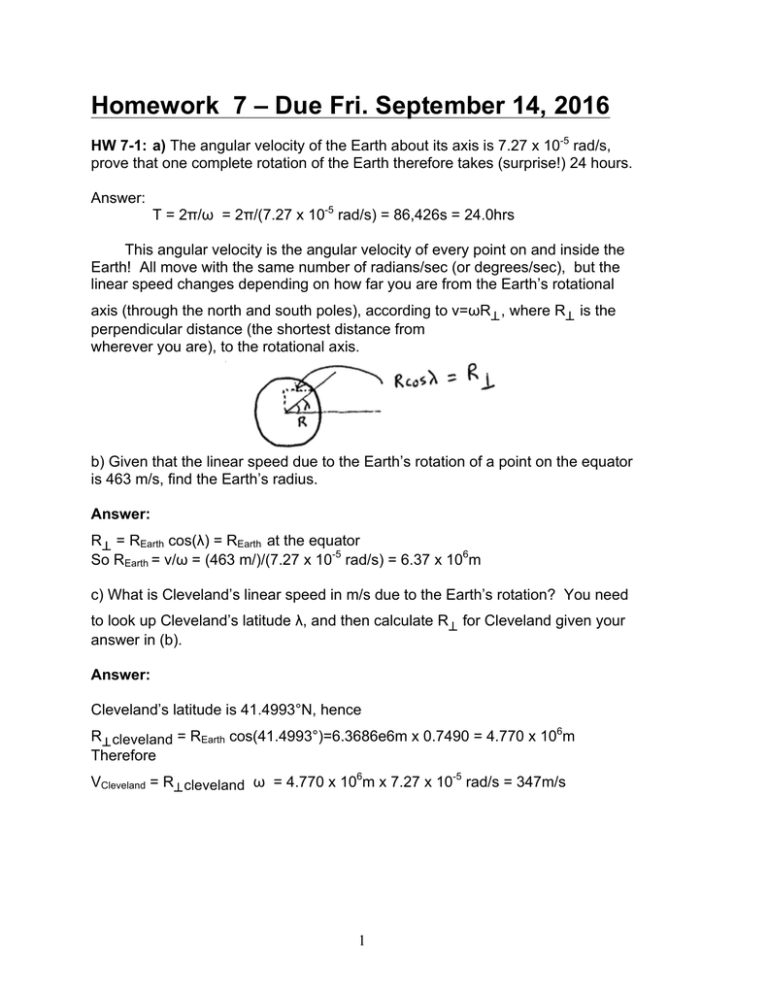Homework 7 – Due Fri. September 14, 2016
advertisement

Homework 7 – Due Fri. September 14, 2016 HW 7-1: a) The angular velocity of the Earth about its axis is 7.27 x 10-5 rad/s, prove that one complete rotation of the Earth therefore takes (surprise!) 24 hours. Answer: T = 2π/ω = 2π/(7.27 x 10-5 rad/s) = 86,426s = 24.0hrs This angular velocity is the angular velocity of every point on and inside the Earth! All move with the same number of radians/sec (or degrees/sec), but the linear speed changes depending on how far you are from the Earth’s rotational axis (through the north and south poles), according to v=ωR⊥ , where R⊥ is the perpendicular distance (the shortest distance from wherever you are), to the rotational axis. b) Given that the linear speed due to the Earth’s rotation of a point on the equator is 463 m/s, find the Earth’s radius. Answer: R⊥ = REarth cos(λ) = REarth at the equator So REarth = v/ω = (463 m/)/(7.27 x 10-5 rad/s) = 6.37 x 106m c) What is Cleveland’s linear speed in m/s due to the Earth’s rotation? You need to look up Cleveland’s latitude λ, and then calculate R⊥ for Cleveland given your answer in (b). Answer: Cleveland’s latitude is 41.4993°N, hence R⊥ cleveland = REarth cos(41.4993°)=6.3686e6m x 0.7490 = 4.770 x 106m Therefore VCleveland = R⊥ cleveland ω = 4.770 x 106m x 7.27 x 10-5 rad/s = 347m/s 1 1 rpm. When the power to 3 the turntable is turned off, the turntable slows down at a constant rate of 0.20 rad/s2. (a) How many seconds elapse before the turntable stops? HW 7-2 An old phonograph turntable is turning initially at 33 Answer: ωo = (33 1 rpm) (2π)/(60s/m) = 3.49 /s 3 ω (t) = ωo – α t. At the end, ω=0, so t = ωo/α = (3.49 /s)/(0.20 /s2) = 17.45s ≈ 17.s (b) How many revolutions will the turntable make before stopping? Δθ = ωo t – ½ α t2 = ωo (ωo/α) - ½ α (ωo/α)2 = ½ ωo2/α = 30.45 radians ≈ 4.8 revolutions HW 7-3 A diver of weight 580 N stands at the end of a 4.5-m diving board of negligible weight. The board is attached to two pedestals 1.5 m apart, as shown in the figure. Find the values of the vertical forces exerted by the pedestals. What are the directions of the forces? That is, tell whether each pedestal is under tension or compression! Answer: We will take up to be positive. The forces on the board are FL and FR (the forces due to the left and right pedestals), and Fg = -mg, the weight of the diver downward. Actually, to be careful, we should say that the diver has two forces acting on her, her weight (gravity) and the normal force upward due to the board. They balance, so that normal force is equal to her weight. Then the 3rd force on the board is the 3rd-law (action-reaction) pair to the normal force Fboard-diver which is equal to the negative of the normal force, and so is equal to the diver’s weight downward. These three forces give not acceleration, and so FL + FR - m g = 0 Now we need a second condition in order to find both unknown forces. This is that the net torque is zero. We can choose which point to take the torque around. A first easy choice is the leftmost end of the board. 2 Then: τL = 0, τR = 1.5m FR, τdiver = -(4.5m) mg Note that the important things is that τR and τdiver have opposite signs. There is no net torque, so 0 = τL + τR + τdiver = 0 + 1.5m FR -(4.5m) mg , teaching us that FR -(4.5m) mg /(1.5m) = 3mg We can then solve our earlier 2nd law equation to find FL = -2mg. Alternately, we could take the torque around the rightmost pedestal, in which case τL = -1.5m FL, τR = 0 and , τdiver = -(3.m) mg. Note now my sign choice which gives τL and τdiver the same sign IF FL>0. Now, the condition of no net torque gives us: 0 = τL + τR + τdiver = -1.5m FL+0 -(4.5m) mg , and so FL= -2mg. The 2nd law then gives us FR = 3mg. Other choices are possible. They all give the same answer. Of course. 3 HW 7-4 Prove the law of sines Hint: A = B sinα sinβ using the cross product. C × C = 0 = C × (A + B) ⇒ C × A = -C × B Answer: The hint is pretty much the answer: C × C = 0 = C × (A + B) ⇒ C × A = -C × B but 𝐶 × 𝐴 = 𝐴 𝐶 sin 𝛽 and 𝐶 × 𝐵 = 𝐵 𝐶 sin 𝛼 So 𝐴 𝐶 sin 𝛽 = − 𝐵 𝐶 sin 𝛼 The law of sines follows trivially. 4



